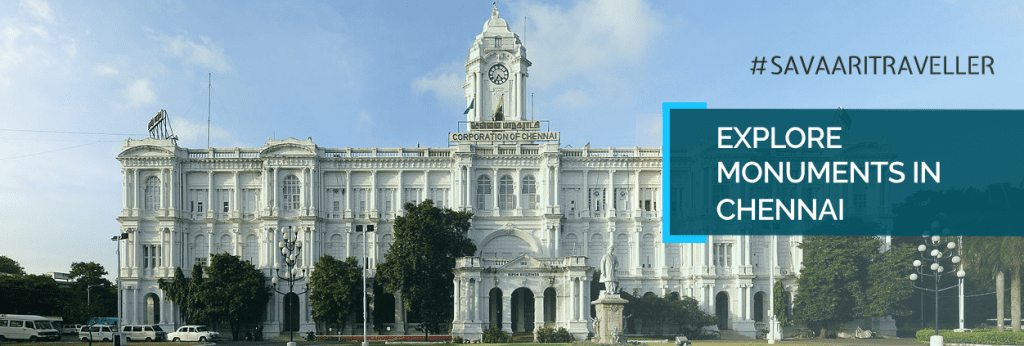7 historical monuments of Chennai you must visit
Tucked on the southeast corner of the Coromandel Coast, off the Bay of Bengal, sits the fourth largest metropolitan of India. The 400-year-old port city boasts a long history of being an important trading center for English East Indian Company in the 1600s to being the technology and manufacturing hub of millennial India. Steeped in history across all its corners, the erstwhile city of Madras came to be the 31st metropolitan area in the world! So, whether you are a history buff or not, a trip to this southern empire is incomplete without paying a visit to its most celebrated and recognized monuments. Each of these structures has a story of their own and deserve to be explored, known and talked about.
Here are our top picks of Chennai’s must-visit historical monuments:
Fort St. George
The first ever establishment built by the British rulers in India, Fort St. George is the most popular historical landmark of Chennai. Established in 1640, this initially used to be a trading center for the British East India Company. Later it served the function of a secured fort to combat the French invasion and the raids of Hyder Ali, the ruler of Mysore of that time. Open to the public on all days from 10 am to 5 pm, this fortress lets you can walk around and fascinate yourself with its rich history. The fort premise comprises the Fort Museum, displaying weapons, armor, and memorabilia of Tipu Sultan supplemented with a library that preserves old, rare books and manuscripts. You can also visit the St. Mary’s Church onsite, which is one of the oldest British churches in the country. Currently, the fort houses the administrative offices of the state government and the Legislative Assembly and overseen by the Archeological Survey of India.
Valluvar Kottam
The Southern architectural style never ceases to mesmerize its audience. Valluvar Kottam is one such structure made of stone. Built in 1976, this prominent landmark honors the legendary Tamil poet and saint Tiruvalluvar. Made with 3000 stone blocks, this edifice flaunts the shape of a 39-meter high chariot. The massive auditorium on the premise to house 4000 people makes it the largest in Asia. You can view the life-sized statue of the great poet and inscriptions of all 133 chapters of Thirukkural- his classic work.
Madras War Cemetery & Memorial
For a city so prominent in the colonial history, it’s only justified to have a significant cemetery. More like a Memorial of a sort, the Madras War Cemetery was set up in 1953 to commemorate those who sacrificed their lives in World War II. The souls of men, women, children, and soldiers of different nationalities rest in peace in this vast expanse of greenery.
Doveton House
If you are an architecture and history lover, then you would surely find the Doveton House awe-inspiring. In 1798, this classic European building was designed and built by the legendary architect Benjamin Roebeck. Dedicated to Lt. General John Doveton, this place served as a lodging place for the English officers and also as a prison to keep the guilty under vigilance. Now, the Doveton House and its 20-acre lush green surroundings, work as the administrative office of Women’s Christian College.
Armenian Church
Though originally a place of worship, the Armenian Church of Chennai is recognized more as an important historical structure. The highlight of this church is its magnificent belfry with six huge bells that chime all at once, every Sunday morning. It was built in 1772, on the former Armenian Cemetery that existed on this site. Currently, a heritage site, frequented by tourists and historians, the church is managed by the Armenian Church Committee of Kolkata.
Prakasam Salai
Also formerly called Popham’s Broadway, this architectural milestone was built in 1795. Today you will find this to be a popular tourist spot of Chennai. Its red-brick structure, built in an Indo-Saracenic style with unique design, invites architecture enthusiasts. The premise houses a few shrines like Kandaswamy Koil, Tucker’s Church, Wesleyan Chapel and Anderson’s Church.
Rippon Building
Named after Lord Rippon, the Governor General of India of 1913, this public building is an architectural wonder in itself. Built by Loganatha Mudaliar this rectangular edifice boasts a 43-meter high tower with a 2.5 meter high Westminster Chiming Clock. Today, apart from being a popular landmark of the city, the Ripon building remains the official seat of the Chennai Corporation.
Freemason’s Hall
If you thought Freemasons only existed in the Americas, then you would be mistaken. Because, we have Indian chapters of the Freemasons in different regions, Chennai being one of the oldest. The Freemason Hall in the Egmore region of the city. The world’s largest fraternal order, started in Europe in 17th century and was aimed at providing aids and teaching moral philosophy to its members. The Freemason Hall in Egmore region in Chennai was established in 1923 and served as a military lodge for the British soldiers. Built in the ancient Greek style architecture, this historical building is a standing testament of the city’s socio-cultural development.

